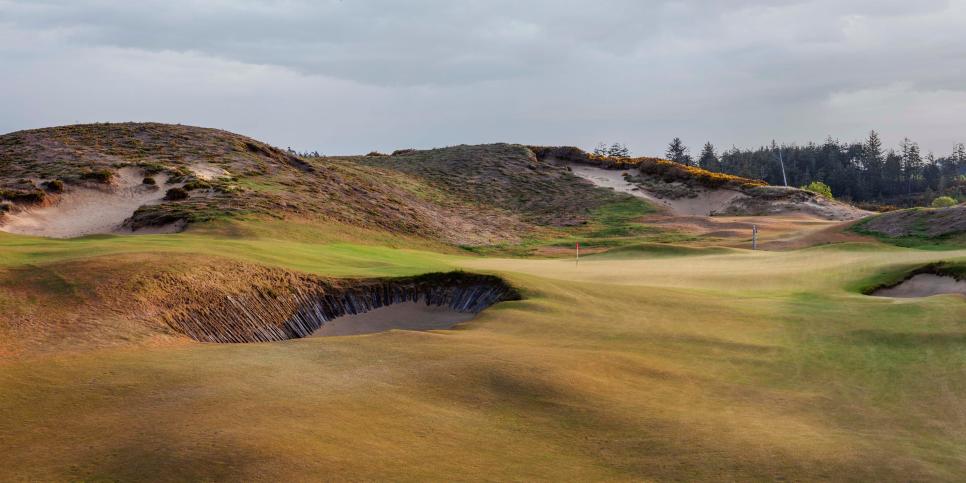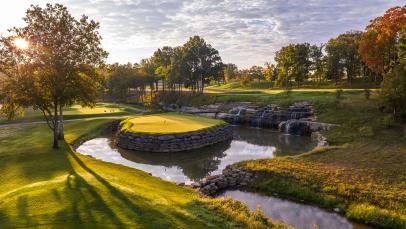Revenge of the Bunkers: Why today’s architects are back to being so wicked – Australian Golf Digest

- by Admin
- May 7, 2024

Leading up to the 1953 U.S. Open at Oakmont Country Club, the USGA and club officials clashed over Oakmont’s use of its heavy, wide-tined bunker rakes. The governing body, as well as many U.S. Open participants, complained that the deep furrows the rakes made were overly penal and inconsistent—one player’s ball, for example, might sit up on the berm between the grooves, presenting an attractive lie, and others settled at the bottom of the rut, requiring uncontrollable explosion shots. The club countered: That’s the way it has always been at Oakmont; deal with it. The implication of the USGA’s position, however, was that the U.S. Open might not return to Oakmont if modifications weren’t made. The sides reached a compromise—the furrowing rakes would be used in greenside bunkers only, but fairway bunkers would be conventionally raked. The same arrangement was in place when the U.S. Open came back to Oakmont in 1962, but the wheels of bunker equity, even for the membership, had been put in motion, and the heavy rakes became permanent relics shortly afterward.
The retirement of Oakmont’s furrows illustrates how attitudes toward bunkers have changed. The tolerance, and even embrace, that previous generations had for random lies and sometimes impossible recovery shots waned in the decades after World War II leading to a long period of bunker neutralization. As golfers began to expect fairness and uniformity, courses took pains to groom, soften and even fill in ornery bunkers, many importing designer sand that enhanced the way the ball sat up. Architects didn’t stop building bunkers, but their emphasis tilted toward utility and aesthetic composition rather than damnation.
Recently the cycle of appeasement has shifted. Bunker wickedness is enjoying a resurgence. Architects are embracing the poignancy and peril of penalty as they craft deep, wind-whipped prairie traps, bombed-out craters with vertical façades and cascading landslides of silica that might leave a player one or more stories beneath the green. We behold anew unmistakable hazards, visually and often physically arresting, with no promise of fair treatment.
I asked architect Gil Hanse about the severity of one such bunker, the cavern he and partner Jim Wagner excavated in front of the 17th green at their new public course in Florida, The Park West Palm, a par 3 that ranges from 164 to just 89 yards. I could imagine dozens of poor daily-fee golfers, many of whom might not even keep a handicap, blindly flailing away in the sand from almost 10 feet beneath the putting surface. Hanse pointed out all the grass and fairway to the right of the green and said, at last after some indignation, “If you’re in that bunker, that’s on you.” The implication was clear: Architects today will give you playing options, but they’ll no longer tailor hazards for convenience.
THE BRONZE AGE
In the beginning it was understood: Bunkers were hazards. Because they occurred naturally in the fields and links where golf developed, bunkers were unkept sandy pits, scars and uneven scabs of earth that were sometimes grassy and lined with thorny gorse. In the elongated lines of dunes near the sea they could resemble vast ramparts, possibly unbreachable by club or boot. At the next turn they might come in the form of a crude blowout or gnarly hollow barely wide enough to execute a swing.
OTHERWORLDLY Old Macdonald’s bunkers harken to another time and place—the links.
Brian Oar
As golfers trampled common pathways between the natural landforms—the first “courses”—these bunkers became permanent markers that gained notoriety as vectors of ill consequence, to be avoided at all costs. The most ominous earned reverential reputations and colorful names like “Himalayas” (St. Enodoc), “Sahara” (Prestwick), “Big Bertha” (Royal Portrush), “Soup Bowl” (Rye) and “Hell” (St. Andrews). At the Old Course they became anthropomorphized personalities, like denizens of a town: Strath, Cartgate, Deacon Sime.
Later, when professionals in the United Kingdom began constructing artificial bunkers on new inland courses, they tried to emulate the old links bunkers by digging crude, rectangular cavities and deep trenches that had none of the sublime naturalness of their inspiration but all the cruelty.
THE ENLIGHTENMENT
The science of course construction progressed into the 20th century, but architects did not generally dumb down their bunkers. Oakmont founder H.C. Fownes, holding Calvinistic views of crime and punishment, at least toward golfers, instructed crews to add new bunkers wherever the better players were hitting the ball. At one point Oakmont was said to have more than 350 such hazards, each prepped with the infamous rake. Early Oakmont might have been pointedly sadistic, but more enlightened practitioners used bunkers for stringent strategic purpose. They understood that there can be no strategy without risk, and there’s no risk without the threat of dire penalty.
C.B. Macdonald’s bunkers at National Golf Links of America (1911) and the extinct Lido (1917), both on Long Island, were some of the deepest built to that point, often cut eight or more feet below a wall of grass. Macdonald’s protégés Seth Raynor and Charles Banks replicated these bunker templates across the Eastern and Midwestern United States through the 1920s, as did William Langford and Theodore Moreau, who similarly shoveled bunkers into steep, fortress-like inclines. Pine Valley (established in 1913), perennially regarded as one of the two or three best courses in the United States, didn’t rake its bunkers or expansive wastelands of sand, and straying into them usually meant playing out of a footprint or from behind a bush. Walter Travis, Alister MacKenzie, A.W. Tillinghast, George Thomas and their peers all developed unique modes of bunkering, none of it sympathetic.

WASTED Wastelands like this bunker at Cuscowilla’s fifth have brought back the fear factor.
Dave Sansom
WE BEHOLD A NEW UNMISTAKABLE HAZARDS WITH NO PROMISE OF FAIR TREATMENT.
If participants of the era took in stride the poor fate of being ensnared in an inescapable trap (at least compared to golfers today), it was largely because of the primacy of match play in day-to-day golf. Players had always kept track of their score totals, but competitions typically took the form of matches (including the sport’s most glamorous tournament, the U.S. Amateur) where if a player took three shots to get out of a hazard, he might lose the hole, but it wouldn’t ruin the entire round. Golfers could chalk up such situations to bad luck or rub of the green, then gleefully await a role reversal on the next hole.
More From Golf Digest  PGA Championship Golf Digest Logo The five holes that will decide the PGA Championship
PGA Championship Golf Digest Logo The five holes that will decide the PGA Championship  book excerpt America’s Greatest Guest
book excerpt America’s Greatest Guest  Cover Story Golf Digest Logo Tom Kim dreams big THE ERA OF GOOD FEELING
Cover Story Golf Digest Logo Tom Kim dreams big THE ERA OF GOOD FEELING
This mind-set began to change with the ascendance of professional golf. Through the Great Depression, amateur golf eclipsed the professional game in popularity and status, and many of the best players, including Bobby Jones, chose to remain amateurs rather than grind out a highway life on the low-paying professional circuit. The advent of the Masters in 1934 (its success fostered by respect for Jones, the founder) and a new breed of professionals that included Sam Snead, Byron Nelson and Ben Hogan helped put professional golf on a different trajectory.
Increased interest in professional golf stimulated a growing antipathy toward overly penal bunkers as interest shifted from match play to stroke play, the scoring metric of the Professional Golfers’ Association of America, and the calculus of 54-and 72-hole totals. With every swing vital to the outcome of a tournament, the acceptance of a double or triple bogey because of disaster in an overly severe or unkempt bunker became not just a matter of psychology but of livelihood.
By the late 1950s and ’60s, television transformed players like Arnold Palmer, Jack Nicklaus and Gary Player into household heroes and the lens through which many recreational golfers came to know the game. That game looked ordered and clean. Their fame and ubiquity, along with an exploding middle class, helped create the biggest boom in golf participation to date and accelerated the evolving view of what was fair and what wasn’t. Fans could read about Snead losing the 1939 U.S. Open by making an 8 on the 72nd hole, including taking two shots to extricate his ball from an insidious bunker, but witnessing this kind of tragedy on the small screen was more viral and more ghastly. The courses that hosted professional events started to be prepped to perfection. Augusta National replaced its tan, powdery bunker sand in 1974 with a new bright white type called Spruce Pine that eliminated the fried-egg lies that were common before. As millions of new golf fans became accustomed to watching famous players hit controlled shots from bunkers like these, they envisioned—and expected—the same.
The trickle-down standard of fairness made its way to golf architecture. To meet rising demand, a frenzy of new construction of primarily municipal and public courses continued through the 1960s. The new demographic demanded courses that were affordable, easily maintained and not overwhelming to play. This meant shallower bunker slopes and simplified edges built by large machines rather than artisanal labor, with the increased probability that even novice players could advance their ball. At the same time, the courses of the 1910s and ’20s were being renovated and retrofitted to modern conceptions of playability, their formerly great and terrible hazards mellowed in the name of cost-saving and equity.
THE GREAT AWAKENING
Not every bunker built on the thousands of new courses introduced in the decades after World War II was designed for convenient upkeep and fairness. Robert Trent Jones famously remodeled U.S. Open and PGA Championship courses in the 1950s and ’60s with the intent of intensifying their shot demands, often by deepening bunkers and using them to squeeze fairways. Dick Wilson fronted elevated greens with high, flashed-faced bunkers as a tactic to defend against a contemporary aerial game powered by an advanced generation of equipment technology, though they mostly caught lesser-skilled players. Few would call the bunkers Pete Dye built at courses like Harbour Town, TPC Sawgrass or PGA West congenial, even though players were allowed to ground their clubs in his intimidating-looking waste bunkers.
Bunkering throughout the 1980s and ’90s from designers like Tom Fazio, Arthur Hills, Tom Weiskopf and Robert Trent Jones Jr. was increasingly fashioned with more helpful, artistic intent: as unreachable aiming points, to aesthetically define fairways and greens, to signal danger areas to avoid and to stop shots from rolling into worse positions. To find a shot in an unraked hazard would be an injustice turning even opponents into sympathetic advocates of relief.
The real bunker awakening occurred at Sand Hills Golf Club in Nebraska by Bill Coore and Ben Crenshaw, opened in 1995. Their choppy, wind-blown hazards were indistinguishable from the actual blowouts that occur with frequency throughout the inhospitable 20,000-square-mile Sandhills region, and they were intensely punishing. Hitting into the wrong part of a bunker carved into the face of a tall dune could destroy a score. At Sand Hills, Coore and Crenshaw’s shapers, particularly Dave Axland, popularized a technique called “chunking” in which native grasses are transported from non-playable areas and planted along the borders of the bunkers to give them a natural appearance. The equipment used included track hoes with articulated, smaller-than-normal buckets that could pivot and rotate to create irregular cuts rather than the straight or curved edges that limited larger machines. This combination makes the bunker appear that it evolved from the site. When golf balls are swallowed by the bushy fescues ringing the edge, being just outside the bunker was sometimes worse than being in it.
RENAISSANCE
For a long time, bunkers had been taken for granted, viewed as perfunctory design ingredients or nuisances to keep golfers honest. The success and popularity of Sand Hills (it won Golf Digest’s Best New Private Course award and ranks eighth on America’s 100 Greatest Courses) gave architects license to break predictable formats and construct meaningful bunkers in every size and shape. Coore and Crenshaw continued to advance their eroded, naturalistic look in the late 1990s and early 2000s at places like Cuscowilla—where Jeff Bradley, now considered the most influential bunker shaper in the profession, garnered acclaim with rustic, chewed-edge hazards gouged out of the Georgia red clay—as well as Old Sandwich near Boston and Bandon Trails.

NO SYMPATHY Mike Strantz showed little remorse for golfers who missed Tobacco Road’s ninth green.
Brian Oar
Several colliding trends in the early 2000s contributed to the bunker revival. First, a contingent of designers emerged, including Hanse, Mike DeVries, Tom Doak, Mike Strantz and Michael Hurdzan and Dana Fry, who took architectural inspiration from the past far more than their predecessors had, specifically the British links and the architecture of the 1920s. This translated into more rugged and naturalistic bunker expressions and the notion that a little pain is an acceptable consequence of tactical error.
Another was the increased development of courses on sand-based sites like Bandon Dunes, Arcadia Bluffs, Dismal River, Friar’s Head and, later, Streamsong, Gamble Sands, Sand Valley, Ohoopee Match Club, Congaree, CapRock Ranch and Pinehurst No. 10. Working in malleable sand gave shapers the freedom to dig deeper and experiment with forms and edging (sand is more pliable and forgiving than clay or other heavy soils), and the pristine locations—coastal bluffs, sandy uplands, reclaimed mining operations, inland dune forests—encouraged a style of bunkering that reflected the scope and eccentricities of these sites.
MORE: America’s 100 Greatest Golf Courses
NEOCLASSICISM
A decades-long movement to reconstruct the original design features of architects like MacKenzie, Tillinghast, Donald Ross and Perry Maxwell has also invigorated bunkers. Macdonald’s pits and embankments at National Golf Links are the model for the provocative hazards found across Old Macdonald at Bandon Dunes. Those at The Lido at Sand Valley, the new replication of Macdonald’s original Lido (with construction oversight by Doak), were rebuilt in exacting detail. Andrew Green has recently demonstrated how uncompromising Ross’ deep, grass-faced bunkers once were at Oak Hill’s East Course in New York and at Inverness Club and Scioto in Ohio, and Gil Hanse’s interpretation of Thomas’ filigreed-edge bunkers at Los Angeles Country Club factored heavily in the 2023 U.S. Open.

DEN OF UN-EQUITY Surviving bunkers like The Park’s 17th usually means avoiding them altogether.
Jensen Larson
Hitting into hazards like these may extract a half or full stroke penalty, but they don’t make the golf penal. Mimicking the character of links, often played in unrelenting crosswinds, requires building fairways with space and bail-out room around the greens, as Hanse pointed out at The Park. The same is true when emulating the classical courses of the 1920s. Those architects understood that golf should be a game of degrees and decisions, and they provided different skill sets ways to play holes. The bunkers might cause wreckage, but there are ways around them.
If anything, designers are becoming more irreverent when it comes to equity. Kyle Franz, who learned the craft working for Doak, Hanse and their associates, is one of the profession’s most intuitive sculptors in the medium of sand. His new Karoo Course at Cabot Citrus Farms, built over the top of Fazio’s old Pine Barrens course (itself a revelatory composition of exposed sand, pines and turf when it opened in 1994), is a dizzying, scorched-earth labyrinth of split fairways and alternate routes around deep cuts of sand. There’s no legend for how to play it, and the message is implicit: Figure it out.
Fry and partner Jason Straka recently built 27 holes at Union League National in southern New Jersey. Players who hit into one of the seven bunkers right of the eighth green on the Sherman nine will find themselves standing one shoe hip-high and hitting back up to a flag they can’t see eight or 10 feet above their head. This is only one of many holes here capable of producing these types of calisthenic contortions.
The 20-foot-deep bunker cut into the rise of the 18th green at Landmand, a sprawling hilltop layout in northeast Nebraska from Rob Collins and Tad King, architects notoriously unsympathetic to dictates of fairness, makes Hell at St. Andrews look unremarkably secular. The fairway, however, is 130 yards wide, the green is more than 15,000 square feet, and there’s considerable runway around the hazard. I was overly aggressive with my second shot and found myself in its bowels. Six strokes later I was out. That was on me.
MANY OF TODAY’S BUNKERS MIGHT CAUSE WRECKAGE, BUT THERE ARE WAYS AROUND THEM.
Golfers’ relationship with bunkers is complex. Professionals still expect to play from bunkers that are predictably raked and consistent, and recreational golfers in $5 Nassaus feel the same. The USGA even modified the rules to allow loose impediments to be removed in the sand, perhaps the logical conclusion for where the governing bodies and professional tours have been headed for decades. Had the rule been in place in 2004, Phil Mickelson might own the Grand Slam. Leading by one at Shinnecock Hills in the final round of the U.S. Open, he noticed a small rock behind his ball in the bunker short left of the par-3 17th. The object made the ball come out hot and finish above the hole, leading to a three-putt double bogey. Was this fair? That’s debatable, but the question obscures a more important point, one that Mickelson acknowledged—he should have never been in that position in the first place. The bunker served its purpose. It was a hazard. Hazards should come with a cost.
Attitudes of equity have become secondary to the desire for more thought-provoking holes, even if these holes trend a little severe. Designers and developers accept what had always been a cardinal truth, that fairness is a construct that’s not written into the historical golf code. Bunkers are not meant to be friendly. The architect’s job is to use them to create interest. It’s the job of the player to avoid them.
More From Golf Digest  Branded Content Caesars Sportsbook Leads the Pack as Golf Betting Enters North Carolina
Branded Content Caesars Sportsbook Leads the Pack as Golf Betting Enters North Carolina  Q&A Golf Digest Logo What’s next? The minds behind some of golf’s biggest fashion brands offer their visions
Q&A Golf Digest Logo What’s next? The minds behind some of golf’s biggest fashion brands offer their visions  LPGA Tour Nelly Korda spotted in stunning dress at the 2024 MET Gala
LPGA Tour Nelly Korda spotted in stunning dress at the 2024 MET Gala
This article was originally published on golfdigest.com
The Latest News
-
December 23, 2024Australian tennis star Max Purcell suspended for doping violation
-
December 23, 2024Aussies complete series clean sweep against New Zealand
-
December 23, 2024Annabel Sutherland’s sizzling summer continues as Australia ease to win over New Zealand
-
December 23, 2024BREAKING: Aussie grand slam champ accepts anti-doping ban
-
December 23, 2024Kyrgios return ‘super exciting’ for Australian tennis says Alex de Minaur





